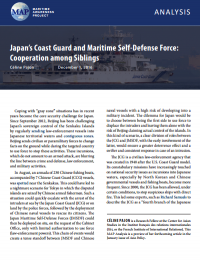Gateway to Think Tanks
| 来源类型 | Publications - External Publications - External Articles |
| 规范类型 | 其他 |
| Japan’s Coast Guard and Maritime Self-Defense Force: Cooperation among Siblings Analysis, Maritime Awareness Project | |
| Céline PAJON | |
| 发表日期 | 2016-12-01 |
| 出版年 | 2016 |
| 概述 | Coping with “gray zone” situations has in recent years become the core security challenge for Japan. Since September 2012, Beijing has been challenging Japan’s sovereign control of the Senkaku Islands by regularly sending law-enforcement vessels into Japanese territorial waters and... |
| 摘要 |
Japan’s Coast Guard and Maritime Self-Defense Force: Cooperation among Siblings Analysis, Maritime Awareness Project
Coping with “gray zone” situations has in recent years become the core security challenge for Japan. Since September 2012, Beijing has been challenging Japan’s sovereign control of the Senkaku Islands by regularly sending law-enforcement vessels into Japanese territorial waters and contiguous zones.  Beijing sends civilian or paramilitary forces to change facts on the ground while daring the targeted country to use force to stop these activities. These incursions, which do not amount to an armed attack, are blurring the line between crime and defense, law enforcement, and military activities. In August, an armada of 230 Chinese fishing boats, accompanied by 7 Chinese Coast Guard (CCG) vessels, was spotted near the Senkakus. This could have led to a nightmare scenario for Tokyo in which the disputed islands are seized by Chinese armed fishermen. Such a situation could quickly escalate with the arrest of the intruders at sea by the Japan Coast Guard (JCG) or on land by the police forces, followed by the deployment of Chinese naval vessels to rescue its citizens. The Japan Maritime Self-Defense Forces (JMSDF) could then be deployed on site, on the request of the Cabinet Office, only with limited authorization to use force (law-enforcement powers). This chain of events would create a tense standoff between JMSDF and Chinese naval vessels with a high risk of developing into a military incident. The dilemma for Japan would be to choose between being the first side to use force to displace the intruders and leaving them alone with the risk of Beijing claiming actual control of the islands. In this kind of scenario, a clear division of roles between the JCG and JMSDF, with the early involvement of the latter, would ensure a greater deterrence effect and a swifter and consistent response in case of an intrusion. This MAP Analysis is a preview of the author’s forthcoming article in the January issue of Asia Policy.
Japan’s Coast Guard and Maritime Self-Defense Force: Cooperation among Siblings
|
| 关键词 | East China Sea maritime security Regional Security Asia Japan |
| URL | https://www.ifri.org/en/publications/publications-ifri/articles-ifri/japans-coast-guard-and-maritime-self-defense |
| 来源智库 | French Institute of International Relations (France) |
| 资源类型 | 智库出版物 |
| 条目标识符 | http://119.78.100.153/handle/2XGU8XDN/416238 |
| 推荐引用方式 GB/T 7714 | Céline PAJON. Japan’s Coast Guard and Maritime Self-Defense Force: Cooperation among Siblings Analysis, Maritime Awareness Project. 2016. |
| 条目包含的文件 | ||||||
| 文件名称/大小 | 资源类型 | 版本类型 | 开放类型 | 使用许可 | ||
| japan_coast_guard_co(70KB) | 智库出版物 | 限制开放 | CC BY-NC-SA |  浏览 | ||
| japans_coast_guard_a(562KB) | 智库出版物 | 限制开放 | CC BY-NC-SA | 浏览 | ||
除非特别说明,本系统中所有内容都受版权保护,并保留所有权利。